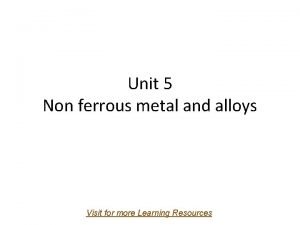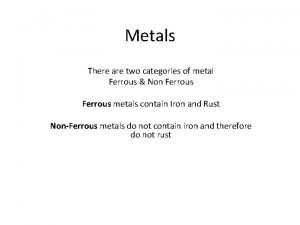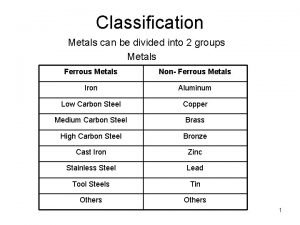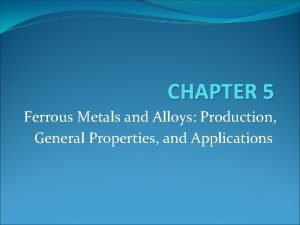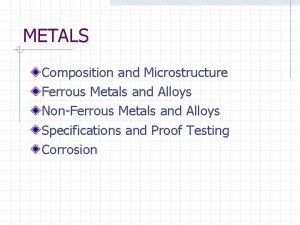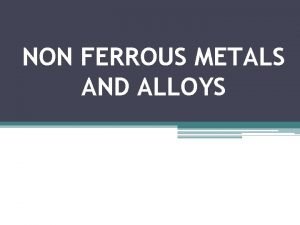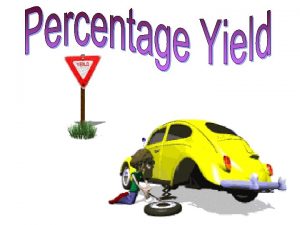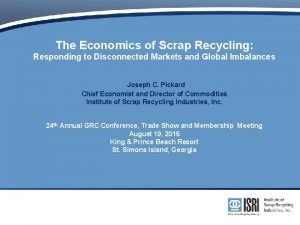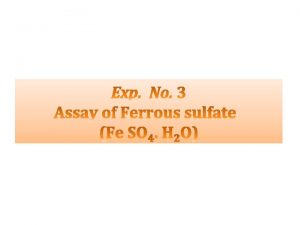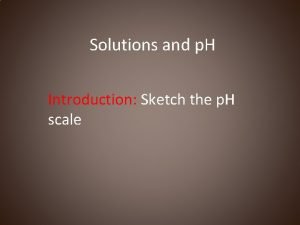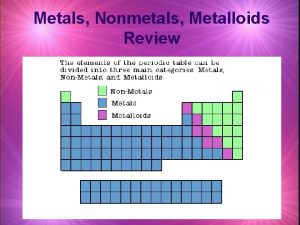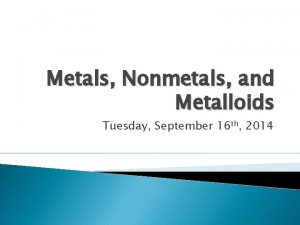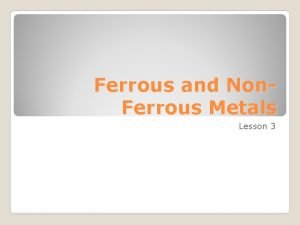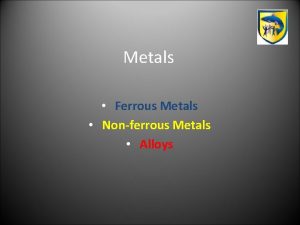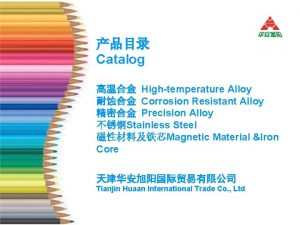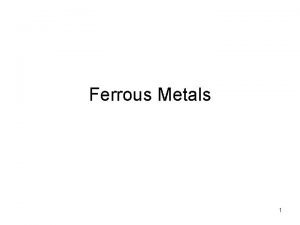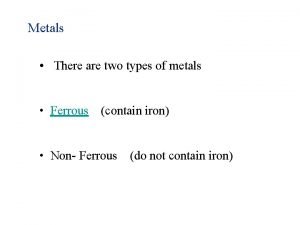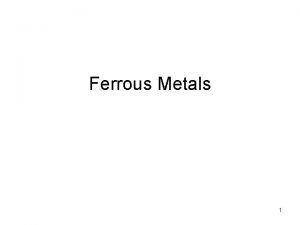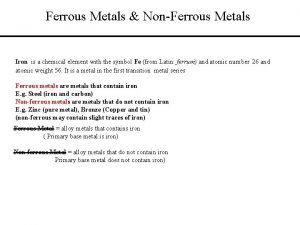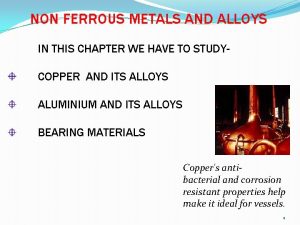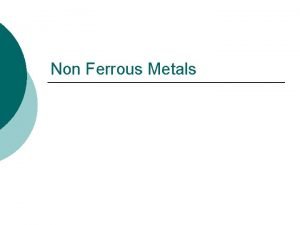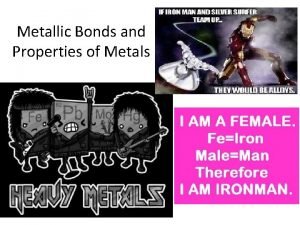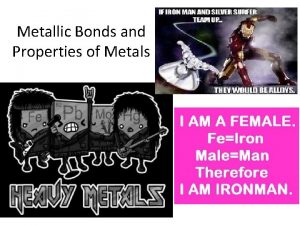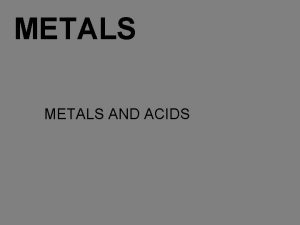Starter Ferrous non ferrous and alloy metals Mild




















- Slides: 20

Starter Ferrous, non ferrous and alloy metals: Mild Steal Aluminium Brass Stainless steel a) Name a suitable non ferrous metal for the base. b) Give three reasons why this non ferrous metal is suitable. 1 mark for each relevant property 1 mark for explanation of each property (max 6 marks)

Starter a) Name a suitable non ferrous metal for the base: Aluminium – other non ferrous might be appropriate but photo is clearly aluminium b) Give three reasons why this non ferrous metal is suitable. Aluminium has a low melting point which makes it ideal for die casting which uses steel moulds and therefore a low melting point metal prolongs the life of the die. Aluminium does not corrode so the colour of the metal and aesthetic appeal is maintained. Aluminium is lightweight in comparison to ferrous metals such as stainless steel. This makes it easier to move around. Aluminium is very a accessible metal ore, meaning the cost for processing it is less. 1 mark for each relevant property 1 mark for explanation of each property (max 6 marks)

Die casting, which is which? Pressure die casting Small, highly detailed components. Die casting Generally low melting point metals, can use gravity of pressure. Ideal for large scale production, mass or continuous. Gravity die casting Gravity is used to force the metal through the die. Die is heated to allow metal to cast at the same time. Pressure die casting - Gravity die casting - Die casting

Die Casting – pages 44 + Task 1: use notes and diagrams to design and plan how you will create your jewellery piece. Use the back of the sheet if you need more space. Name: Task 2: use notes and diagrams to explain how your jewellery piece will be batch manufactured. Select a die casting process and adapt your design to it. Use the back of the sheet if you need more space. Pressure die casting - Gravity die casting - Die casting – Pewter – hot air gun – H&S – Gloves – high pressure - die - spruce - temperature

Polymer Type Application & reasons for use Compostable e. g. Bio-Batch Additive Bio. Pol Shampoo bottles Water Soluble e. g. starch based biodegradbles, Detergent sachets , Medicine capsules (tablets) Considerations: What is the function of the polymer and application? Why is that polymer suited to its job? What does Oxo mean? What does UV mean? Oxodegradable Carrier bags UVdegradable Carrier bags How are they processed? (look at calendaring page 12) What is the lifespan of the product?

Polymer Type Application & reasons for use Compostable e. g. Bio-Batch Additive Bio. Pol Shampoo bottles • Shampoo bottles have a limited life cycle. They would not be kept once empty. They are quickly disposed of and may go to landfill. Bio-batch polymer will degrade if it goes to landfill with the enzymes in the soil. • This type of polymer will not degrade in normal use so it is perfect for the manufacture of bottles. • If separated from other polymers, it can be recycled to produce other items. Water Soluble e. g. starch based biodegradbles Detergent sachets Medicine capsules (tablets) • Water soluble polymers will only degrade in the presence of warm water. This makes it perfect to contain liquids or powders such as medicines or detergents. • Water soluble polymers can be made into film using the calendaring process, required to make sachets. • Water soluble polymers such as acetyl can be made in a transparent form so that the contents can be seen. Oxo-degradable Carrier bags • Carrier bags can be a major litter problem. An additive that makes the polymer break down when exposed to oxygen will ensure the carrier bags are reduced to very small parts and don’t cause long-term litter problems. • Any thermoplastic can be made oxo-degradable, therefore LDPE which is a thermoplastic used in carrier bags is possible to use. • Providing the carrier bags are stored properly in an airtight container-before use, they will not degrade prematurely. UV-degradable Carrier bags The same reasons for use as for Oxo-degradable apply for UV degradable.

AQA session feedback Start with section C, 40 mark section, as it is generally the most time consuming and you will be fresh and ready for the question. Advised by lead examiner. In some questions getting the first answer wrong means you can lose many marks on the following questions, read questions carefully. Do not use the word ‘cheap’, unless you back it up with a comparison in price to another material. There will be Health and Safety questions. Always make a point, about the material, and then explain the property. On the design question , in section C, you must keep the original idea and modify it.

AQA session feedback You must be able to write a step by step for each manufacturing process, i. e. injection moulding / press forming/ piercing and blanking In sections where they ask you to use diagrams they suggest that you use diagrams over text, as more marks are given because candidates can generally draw their ideas better than explaining them using text. Metals are generally candidates weakest area across the country. Candidates generally preform better in plastics and woods. Ensure you have covered compliant materials in revision, graphics materials. do not use the word cheap, use inexpensive.

#Notes from the exam • Some students did not use all space provided on the note and diagram questions. • You must still include detailed notes of the processes. • When creating diagrams for each process ensure the die is shaped like the product in the exam paper, for instance the children’s high chair. Rotational moulding question

#Notes from the exam • In general students performed better in part C (40 marks) than in parts A + B (40 marks). Exam skills – water to stay refreshed? • Clearly core areas should be revised in more detail. • There is no need to rush as students often finish early. Ensure you elaborate fully during the exam. • Acrylic is unlikely to be used over many thermoplastics in a commercial setting, although perfect in school

Starter – How many processes can you name? Polymers Metals Woods Injection moulding Press forming Laser cutting Rotational moulding Piercing and blanking Milling Blow moulding Plasma cutting Sawing – band /circular Thermo / vacuum forming Die casting – gravity / sand Extrusion Cupping 3 D printing Deep drawing

Starter – name materials from each category Polymers Metals Composites ABS (thermoplastic) Mild steel (ferrous) plywood Resin (thermoset) Aluminium (non – ferrous) GRP (glass reinforced fibre) HDPE (thermo) Brass (non-ferrous alloy) Sawing – band /circular PC (thermo) Duraluminium (non ferrous alloy) concrete PP (thermo) Copper (alloy) tungsten melamine formaldehyde Titanium (nonferrous) Cermet (ceramic and metal) (thermoset)

Finishes for plastics • Plastics are self finishing materials. It is the quality of the mould that dictates the smoothness of the finish. • Pigments can be added to alter the colour of the plastic. • Texture, for a bottle grip, could be added to a plastic by making the mould textured.

Finishes for metals Metal finishes are broken down into two finishes, Natural barriers & Applied barriers: • • • You will be researching and explaining the finish to the class. You should bullet point the important information. Include images to back up your points. You may use revision guides / internet. Give examples of where it is used. Electroplating Natural barriers Anodising & powder coating Enamelling & plastic dip coating Dipping, spraying and painting

STARTER – How many finishes can you list for: Material Metal Plastic Wood Finishes

STARTER – copy these and expand on the finish. PEE. Material Finishes Metal Anodising Electroplating Enamelling Powder coating Plastic coating Paints / spray/ rolling / dripping / brushing Natural barriers – ‘blueing’ Plastic Self finishing Self colour – or sprayed textured Wood Paints Varnish Oil - bases Polyurethene Natural barriers – teak oil Laminates Veneers

What is Deburring? Deburring is finishing process that is used to prepare metal or wood for finishing. In olden days when materials were cut/pierced a rough edge would be left. This is called burr. The process for removing this edge is called deburring. This can be achieved by filing, sanding (rotary / sandpaper) wet and dry papering the edges until smooth. In general most modern materials are deburred in production. Processes like laser cutting leave an excellent finish. Woods are generally planed in production, hence PSE (planed square edge).

Homework (out of 18) Read through the 3 D print article for house building Task 1: discuss the potential for additive manufacturing in design and architecture. How will it alter the manufacturing process? What materials could it use? Are there disadvantages for 3 D printing? What are your thoughts? Minimum of 6 points, ideally 8, backed up with explanations and examples (8 marks) Task 2: create a step by step diagram for the 3 D printing process for a plastic chair made from HDPE. Use notes and diagrams to explain your answer (10 marks)

Properties and material testing Hardness – does the material cut easily? Does a dot punch mark the material? Ductility and malleability – can be tested by creating a 90 degree bend. If cracking appears on the outside it is not ductile. If cracking appears on the underside the material is not very malleable Tensile strength – is the amount of energy it takes to bend the material. Applying weight to the material can test this. Toughness – is the material ability to absorb blows, like a hammer blow. Striking different material. Using tools provided test the materials and make notes on the testing…. .

Properties and material testing Hardness – does the material cut easily? Does a dot punch mark the material? Ductility and malleability – can be tested by creating a 90 degree bend. If cracking appears on the outside it is not ductile. If cracking appears on the underside the material is not very malleable. Tensile strength – is the amount of energy it takes to bend the material. Applying weight to the material can test this. Toughness – is the material ability to absorb blows, like a hammer blow, striking different material. Material Mild steel bar Mild steel rod Acrylic MDF Hardness Ductility and malleability Tensile strength Toughness comments
 Ferrous material
Ferrous material 5 non ferrous metals
5 non ferrous metals Categories of metals
Categories of metals Periodic table metals and nonmetals
Periodic table metals and nonmetals Metal characteristics
Metal characteristics Matter in natural science
Matter in natural science Technology grade 7 term 2 notes
Technology grade 7 term 2 notes Non metal example
Non metal example Classification of metals
Classification of metals 5 ferrous metals
5 ferrous metals Microstructure of ferrous metals
Microstructure of ferrous metals Ferrous material
Ferrous material Compare the properties of metals and nonmetals
Compare the properties of metals and nonmetals Metal and nonmetal
Metal and nonmetal What is the percent yield of ferrous sulfide
What is the percent yield of ferrous sulfide Ferrous scrap
Ferrous scrap Physical properties of ferrous sulphate
Physical properties of ferrous sulphate Draino chemical name
Draino chemical name Dieu tout puissant, quand mon coeur considère partition
Dieu tout puissant, quand mon coeur considère partition Bulletproof metal periodic table
Bulletproof metal periodic table Non metals
Non metals

